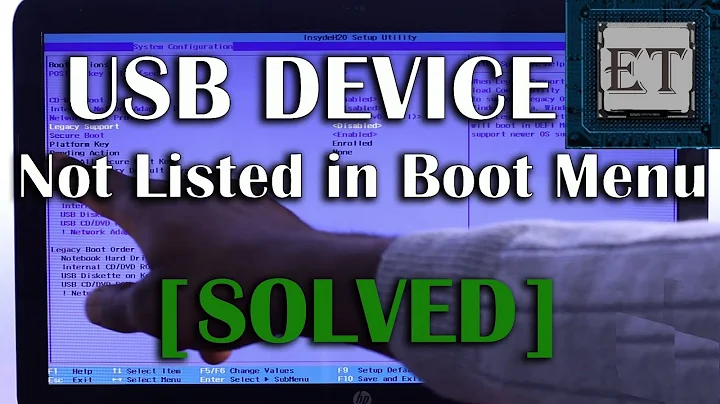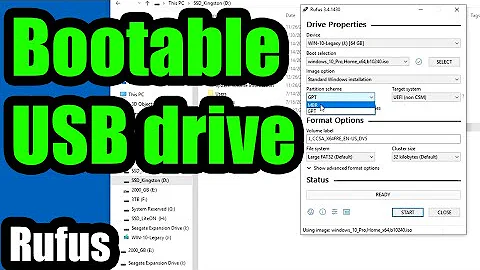What is it that makes some USB sticks not-bootable?
Solution 1
Just want to share my experience. We burn a lot of bootable ISO's to flashdrives to setup anything from Windows server series to Windows 7 through 10. We ONLY have issues with Kingston drives when it comes to this. I spoke to a guy at tech support from Kingston and after a lot of useless info it basically boils down to its not guaranteed to boot. So i tried all the other troubleshooting options like diskpart, full formats and even the linux way of partitioning and formatting. So several days later i checked my bios and as always the USB disk shows as a harddrive like any other brand of USB disk. I noticed there was a note in the right hand page to "press N" to remove the Kingston USB disk as a "harddrive" which will then mark it as a removeable disk. After pressing N the disk disappeared from the harddisk list and i save/rebooted. It works perfect now!!! This wasnt necessary for any of my other USB disks which booted perfectly every time on various hardware platforms except for my Kingston G3 and Fury 3.0 drives.
Hope this could help some other frustrated techie :D
Solution 2
Some usb stick manufacturers factory partition drives with tables not suitable for creating a bootable drive. Formatting makes no difference as it does not affect the tables, just erases the contents of the primary, visible partition. (I had issues with a "reputable" brand before with this issue.)
If you have access to a Linux box, plug the drive in, find what Linux names the device as then run:
dd if=/dev/zero of=/dev/sd***
(change *** to the device name given)
This wipes the drive completely (by filling it with binary zeros), file system, PTs the lot. So make sure you specify the correct device!!! Then reformat (FAT32 is better as UEFI doesn't support NTFS) and you should be good to go.
Solution 3
I dealt with this problem with my SanDisk drive and the only solution for me was to purchase another drive. Check your drive in the "This PC" menu of your computer. Flash drives usually show up as a removable disk. This information about this drive being bootable or or is usually contained within the flash drive itself. Here is mine, for example:  .
.
To protect users from destroying their entire hard drive, Microsoft and other disk burning utilities limit themselves to only being able to burn onto so-called "removable" disks- USB drives, CDs, DVDs, etc. What happened is that some companies (one of them SanDisk) sold misconfigured flash drives with the bit for being removable off. I'm not too sure how exactly this information is stored, but as far as I know there is no way to change the firmware. You'll have to purchase a new flash drive, or alternatively, you may be able to convince the company to give you a refund/replace your flash drive.
Sources:
Solution 4
This is pretty old so maybe you found a solution but for anyone who finds this later, I am posting an answer.
The USB firmware may be the problem. You can update the firmware of a USB device, which may resolve the problem. Here is a link that enumerates various SWs to do so: http://wiki.openmoko.org/wiki/USB_DFU_-_The_USB_Device_Firmware_Upgrade_standard
Solution 5
There is a downloadable program called BOOTIce at www.ipauly.com that I have used to make a Lexar 16Gb bootable that Rufus couldn't. Works a treat! I am no real techy-type person so don't know all the ins and outs of how it does it but it handles the MBR which other pgms haven't been able to. I highly recommend it to solve the problem of a stubborn no boot stick. (I'm not a sponsor nor do I receive a commission for bringing this to your attention...LOL)
Related videos on Youtube
iFreilicht
Updated on September 18, 2022Comments
-
 iFreilicht over 1 year
iFreilicht over 1 yearI recently got a 64GB USB stick and planned to make it a system repair multitool, with different Linux and Windows installers and live images, but I seem to have a USB stick that cannot be booted.
Pendrive Linux' Yumi installer doesn't recognize it, and only lists it when "show all devices" is checked.


The Windows 7 USB install tool doesn't recognize it either.

When putting an image on it with either Yumi or diskpart and xcopy, none of the three PCs I tested are able to boot it, but none of them have problems booting from another smaller, slower 8GB drive. The HP USB format tool, as mentioned in this answer does format it, but that does not enable bootability. I have tried both NTFS and FAT32 filesystems, but neither succeed.
What causes this? I was under the impression that USB sticks are just storage devices (like optical discs) and that it was enough to have the correct files/structures to make it bootable. Is the device missing some critical feature necessary to make it bootable?
Additional Info:
The mainboards of the PCs are the GA-MA770T-UD3 (AM3 socket, probably a bit old), the GA-Q87TN (1150 socket), and whatever is inside the Dell XPS12 9Q33. The latter two run Haswell processors with UEFI, I can't imagine that a 64GB stick would pose a problem.
I also tried formatting with the Windows tools, and tried to make a partition of only 20GB.
-
Lee Harrison over 9 yearsThat is odd, I've never ran into this issue! I've always used diskpart and set the partition as Active and that was enough.
-
 iFreilicht over 9 yearsApparently somebody else's had this problem, too. It looks like there are some flash drives that just can't be booted from.
iFreilicht over 9 yearsApparently somebody else's had this problem, too. It looks like there are some flash drives that just can't be booted from. -
 Ƭᴇcʜιᴇ007 over 9 years
Ƭᴇcʜιᴇ007 over 9 years -
 iFreilicht over 9 years@Ƭᴇcʜιᴇ007 interesting questions and good answers. Unfortunately, neither solve my problem nor do they answer my question. If it is true that the bootable flag has to be set in order for windows to recognise multiple partitions, then it is set on my drive as I tested it with two partitions, and both could be read from and written to without error.
iFreilicht over 9 years@Ƭᴇcʜιᴇ007 interesting questions and good answers. Unfortunately, neither solve my problem nor do they answer my question. If it is true that the bootable flag has to be set in order for windows to recognise multiple partitions, then it is set on my drive as I tested it with two partitions, and both could be read from and written to without error. -
 Ƭᴇcʜιᴇ007 over 9 yearsDoes Windows give you the Eject option for that drive when it's plugged in?
Ƭᴇcʜιᴇ007 over 9 yearsDoes Windows give you the Eject option for that drive when it's plugged in? -
 iFreilicht over 9 yearsYes, and the device shows up as expected. Files can be written and read with no problem at all.
iFreilicht over 9 yearsYes, and the device shows up as expected. Files can be written and read with no problem at all. -
 I say Reinstate Monica over 9 yearsIn Windows, have you tried using the
I say Reinstate Monica over 9 yearsIn Windows, have you tried using theCLEANcommand inDISKPART? This should destroy all partition data and give the drive a RAW partition. From there you would need to re-apply your boot configuration to the drive. -
 iFreilicht over 9 years@Twisty I did something similar with Linux, as suggested by one of the answers. I used
iFreilicht over 9 years@Twisty I did something similar with Linux, as suggested by one of the answers. I usedcp /dev/null/ /dev/sdXto wipe the stick completely, including partition table information. This didn't solve the problem, unfortunately. From what I can tell, it seems to be a firmware issue. -
krowe over 9 yearsI'd bet that this is a USB 3 stick and his Mobo doesn't support USB 3 without the kernel mode driver loaded. My mobo won't boot from USB 3. Before I updated the BIOS it wouldn't even list my USB 3 stick on the boot screen but it still doesn't add it to the list of boot drives.
-
 iFreilicht over 9 years@krowe you've bet wrong, it's a USB2 stick. To be precise, the Intenso AluLine 64GB.
iFreilicht over 9 years@krowe you've bet wrong, it's a USB2 stick. To be precise, the Intenso AluLine 64GB. -
wally about 7 yearsI'm reliably told the following is a comment and not an answer. I disagree, but whatever. I had exactly the same issue, was due to the partition size on the stick. Aligns with your observation that the 8GB sick works, but the 64GB stick doesn't. I expect there is a limitation on the size of partitions supported by the boot loader or some such - perhaps someone else can clarify (who's understanding is better than mine). To clarify - the same 64GB stick was used successfully with the smaller partition.
-
-
 Admin over 9 yearsDon't use
Admin over 9 yearsDon't usecp, usedd. I'm not sure whatcpwill do in this case but it may simply destroy the device node (and turn it into a blank file filled with zeros) instead of writing data to the drive. -
 hanetzer over 9 yearsThanks for catching that, I just noticed what he said and was about to freak out D:
hanetzer over 9 yearsThanks for catching that, I just noticed what he said and was about to freak out D: -
Chris Kennett over 9 years
cpwon't destroy it. It copies zeros to the drive, where asddwill delete existing content and write new zeros. Same result with a slightly different way of getting there I guess. Both ways are valid. In factcatwould work to. -
 iFreilicht over 9 yearsI'm not sure what you're recommending. Is your proposed solution to this problem to use a CD/DVD? Because that is absolutely impractical, my pants are not designed to hold CDs in their pockets. Also, what does this have to do with Linux? And, did you read a bit about the software I used? Because Yumi uses the exact Linux tools you described, just with an easier to use front-end.
iFreilicht over 9 yearsI'm not sure what you're recommending. Is your proposed solution to this problem to use a CD/DVD? Because that is absolutely impractical, my pants are not designed to hold CDs in their pockets. Also, what does this have to do with Linux? And, did you read a bit about the software I used? Because Yumi uses the exact Linux tools you described, just with an easier to use front-end. -
 iFreilicht over 9 yearsDoes that mean I could also use the "create partition table" feature of GParted?
iFreilicht over 9 yearsDoes that mean I could also use the "create partition table" feature of GParted? -
 iFreilicht over 9 yearsNevermind, GParted didn't work. Unfortunately, your solution didn't work either. The drive was deleted completely, including the partition table. But after reformatting, the problems all persisted.
iFreilicht over 9 yearsNevermind, GParted didn't work. Unfortunately, your solution didn't work either. The drive was deleted completely, including the partition table. But after reformatting, the problems all persisted. -
 hanetzer over 9 yearsI'm recommending burning to a cd/dvd to have a usable linux userspace to create the usb, not expecting you to carry the cd around with you. And front ends are more of a pain than what their worth; if they do something wrong and the backend doesn't act properly it makes it a bit harder to debug, instead of just reading what stderr has to say about why it broke.
hanetzer over 9 yearsI'm recommending burning to a cd/dvd to have a usable linux userspace to create the usb, not expecting you to carry the cd around with you. And front ends are more of a pain than what their worth; if they do something wrong and the backend doesn't act properly it makes it a bit harder to debug, instead of just reading what stderr has to say about why it broke. -
umop aplsdn over 9 yearsI'm a new user so I can only post 2 links per post, so here's the link to a Google search with a ton more to read: click here
-
barlop over 9 years@ChrisKennett if you copy zeros to the drive then the old values will get deleted. are you saying dd does the same but deletes them beforehand? that sounds a bit longwinded to me, if true, and i'd be surprised if dd were longwinded. so that sounds a bit strange, the way you describe them differently.
-
 iFreilicht over 9 yearsI think you might be on the right track. The drive does indeed show up as "local disk". The stick was a present from my Dad and I don't really want to bother him with returning it, I don't think he even has the receipt.
iFreilicht over 9 yearsI think you might be on the right track. The drive does indeed show up as "local disk". The stick was a present from my Dad and I don't really want to bother him with returning it, I don't think he even has the receipt. -
 DavidPostill about 7 yearsThis is really a comment and not an answer to the original question.
DavidPostill about 7 yearsThis is really a comment and not an answer to the original question. -
wally about 7 yearsDeleted. All yours.
-
RogUE over 6 yearsSo a more specialised formatting application is required to do the job. I disagree, I have done it using cmd and no other applications.
-
ZEE over 5 yearsBooiICE is the best... lots of funcionality beyond partitioning... also handle MBR(s), PBR(s), BCD create/edit, VHD(s), ...





